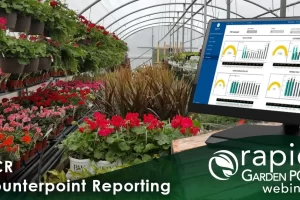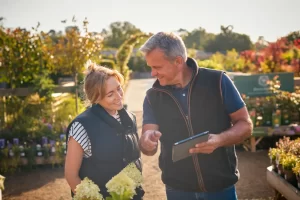There are many independent garden centers that currently do not use technology tools to manage inventory, transactions, and customers for their businesses—I know this because I have probably spoken with 10 green retailers in the past six months that are not even using cash registers to ring up their transactions. While I have a personal mission to help those businesses realize that technology can substantially improve their bottom lines, I am focusing this article toward the IGCs that currently utilize a technology platform such as a point-of-sale system or inventory management system.
It would be fairly typical to hear that a business brought technology into their operation because of one or more “pressing needs” (I label them “technology drivers”).
For many stores, a technology driver might be improved inventory tracking or a quicker, more streamlined check-out process for customers. Other stores are looking to expand selling channels (for example, adding an eCommerce website). Regardless of the technology driver(s) that brought you to your current store system, you selected and implemented a system that addresses your primary technology drivers. And if you are like many of the IGCs I work with, your system becomes part of your day-to-day routine.
When I speak to store owners, I often hear, “I know my system can do a lot more” or, “We aren’t using many of the features that our system offers.” You are not alone. For the last 25 years, I’ve used Microsoft Office almost every workday and I know that I am still only using about 40% of the functionality that is available in the tool. Regardless of what system you are using, my challenge today is: How can I help you tap into your unutilized technology potential to lower costs, increase sales and improve margins?
The golden nugget of wisdom here is simple: each quarter, set a goal to utilize your available technical capability in at least one new way that directly translates to cost savings, higher sales and/or better margins. Start with a brainstorm session with your management team. Throw ideas on a blank page, flip chart or white board. For each idea about how to use your available technical tools, identify the costs, challenges or pains associated with this new use of your technology and identify the value benefit that would result from the use of that tool. Look at the chart above for examples.
All three of these examples use existing technical capabilities of many POS systems, are not overly difficult to implement, and provide tangible benefits that are measurable. Of course, your team will think of 20 clever ideas using this method. Pick the ones that are most compelling for you and make a concerted team effort to implement that approach. Measure the results and used those results when considering the goal(s) for the subsequent quarter.
You will quickly see that utilizing a few more capabilities in your existing system can yield significant economic results.
| NEW TECHNOLOGY USE |
COST/ CHALLENGE/ OBSTACLES |
VALUE/PAYOFF |
|---|---|---|
| Use available inventory reporting to define and measure your buyers’ effectiveness (e.g., track turns, GMROI or weeks on hand metrics) |
Needs a shift in employee culture (they may not like being measured), learning how to generate reports that track these metrics, possibly a need to create specialized reports, the need to learn how to interpret these metrics in an effective way (What is a good GMROI?) |
Lower inventory costs, lower waste, increased sensitivity to overstocks and opportunities to improve margins |
| Use your POS system to track and promote “value attributes” for your items. For example: disease resistant, drought tolerant, pollinator, organic |
Creating attributes on your item records in your inventory system to track and promote these attributes that increase the perceived value of a product. |
Promoting value attributes increases a customer’s perception of value and justifies higher prices and margins |
| Use technologies to encourage your sales staff “up-sell” 5 things in your inventory. For example, when you sell a shrub, have your system prompt the customer service clerk to offer an organic fertilizer that improves root development. |
Changing store clerk behaviors, creating system links to prompt the clerk to ask if a customer would like to add “x” to their order when they purchase “Y.” In Rapid Garden POS, these are called “tag-a-long” items. |
Even if 2 out of 10 customers respond positively to the upsell, that is still 20% of those customers adding a higher margin item to their purchase. This practice can also create a repeatable pattern for that customer (e.g., I always buy this fertilizer when I purchase a plant to be planted). The ultimate benefit is increased gross sales, increased average ticket sales and increased net margins. |
Read the original article here.




